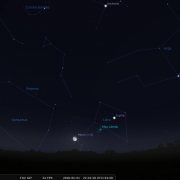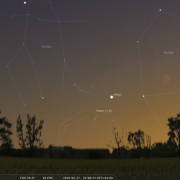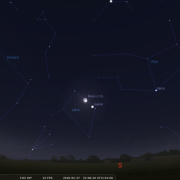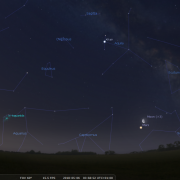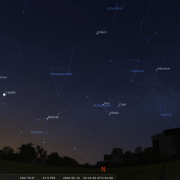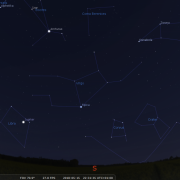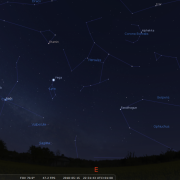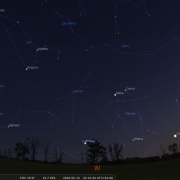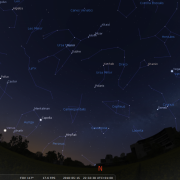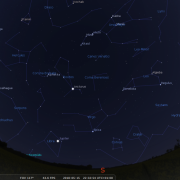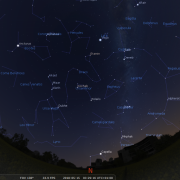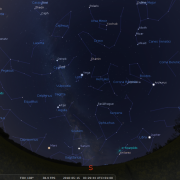In this month's Sky Notes:
Planetary Skylights

 As twilight falls, look to the WNW where Venus dominates, the ‘evening star’ by far the most conspicuous object. Venus starts the month between the Hyades and Pleiades star clusters in Taurus. These will be lost in glare by the second week, but Venus continues to keep pace with the sun, not setting until after 23:00h by the month’s end. View on the 17th around 22:00h and look for a very slim Crescent Moon in earthshine residing lower left of Venus. Through a telescope Venus exhibits a definite gibbous phase, but little else is evident beneath the duvet of cloud cover.
As twilight falls, look to the WNW where Venus dominates, the ‘evening star’ by far the most conspicuous object. Venus starts the month between the Hyades and Pleiades star clusters in Taurus. These will be lost in glare by the second week, but Venus continues to keep pace with the sun, not setting until after 23:00h by the month’s end. View on the 17th around 22:00h and look for a very slim Crescent Moon in earthshine residing lower left of Venus. Through a telescope Venus exhibits a definite gibbous phase, but little else is evident beneath the duvet of cloud cover.
 Opposite Venus and rising in the east, Jupiter is the next most conspicuous planet to the eye; (at least it is until later in the summer) The king of the planets comes to opposition on May 9th –rising as the sun sets, crossing the south meridian around midnight. It is certainly visible by 22:00h at the start of May and is already well above the SE horizon as twilight deepens by the end of the month. Unlike Venus, Jupiter shows a wealth of detail when viewed telescopically, especially the darker belts and other atmospheric markings including the great red spot (when orientated toward us). Look for it on the 4th,6th 9th 11th 16th 18th 21st 23rd 28th & 30th around 22:30-23:00h.
Opposite Venus and rising in the east, Jupiter is the next most conspicuous planet to the eye; (at least it is until later in the summer) The king of the planets comes to opposition on May 9th –rising as the sun sets, crossing the south meridian around midnight. It is certainly visible by 22:00h at the start of May and is already well above the SE horizon as twilight deepens by the end of the month. Unlike Venus, Jupiter shows a wealth of detail when viewed telescopically, especially the darker belts and other atmospheric markings including the great red spot (when orientated toward us). Look for it on the 4th,6th 9th 11th 16th 18th 21st 23rd 28th & 30th around 22:30-23:00h.
The attendant Galilean moons present an ever changing configuration from night to night, and are fascinating to follow. Io’s shadow is visible on Jupiter on the following days during late evening, 9th & 25th. Ganymede’s shadow transits Jupiter on May 6th after 23:00h. Look for a small black dot on Jupiter’s disk. The Full Moon resides upper left of Jupiter on the 1st and again on the 27th when the Moon is not quite full.

 Both Mars and Saturn are still early morning objects, visible for the diminishing hours of darkness after midnight. Saturn rises first, a pearly white presence low to the SE by 02:00h. It resides just above the ‘teapot’ asterism in Sagittarius. Telescopically Saturn is currently a glorious spectacle with the rings orientated very favourably. Look also for Saturn’s largest moon; Titan, visible as a small speck just away from the planet. A waning crescent moon lies off the left of Saturn on the 5th.
Both Mars and Saturn are still early morning objects, visible for the diminishing hours of darkness after midnight. Saturn rises first, a pearly white presence low to the SE by 02:00h. It resides just above the ‘teapot’ asterism in Sagittarius. Telescopically Saturn is currently a glorious spectacle with the rings orientated very favourably. Look also for Saturn’s largest moon; Titan, visible as a small speck just away from the planet. A waning crescent moon lies off the left of Saturn on the 5th.
Look the ruddy hue of Mars rising an hour after Saturn. The red planet is finally growing in brightness and by the end of May exceeds Saturn. Mars is moving away from Saturn in Sagittarius and into the following constellation of Capricornus. Telescopically Mars still appears pretty small, but by the month’s end surface detail will become more apparent through larger aperture instruments. We will have to wait another month before matters really alter. On May 6th a crescent moon lies just above Mars.
Meteors

If you are an early riser look out for some shooting stars around May 5/6th when the eta Aquarid meteor shower reaches a peak. This is one of two meteor showers associated with debris particles deposited over time by comet Halley, the other shower being the Orionids seen in late October.
Eta Aquarids have a ZHR (zenith hourly rate) approaching 30, but with Aquarius only just rising in the SE shortly before dawn, observations from the UK are restricted. The radiant of the shower lies close to eta Aquarius, one of the stars making up the "water jar" in the otherwise faint constellation of Aquarius. View around 04:00h when the setting moon will be low to the WSW.
|
Looking North
Mid-May - 22:30h |
Looking South |
|
Looking East
Mid-May - 22:30h |
Looking West
Mid-May - 22:30h |
|
Northern Aspect
Mid-May - 22:30h |
Southern Aspect
Mid-May - 22:30h |
|
Northern Aspect (Before Dawn)
Mid-May - 03:30h |
Southern Aspect (Before Dawn)
Mid-May - 03:30h |
Additional Image Credits:
- Planets and Comets where not otherwise mentioned: NASA
- Sky Charts: Stellarium Software
- Log in to post comments

